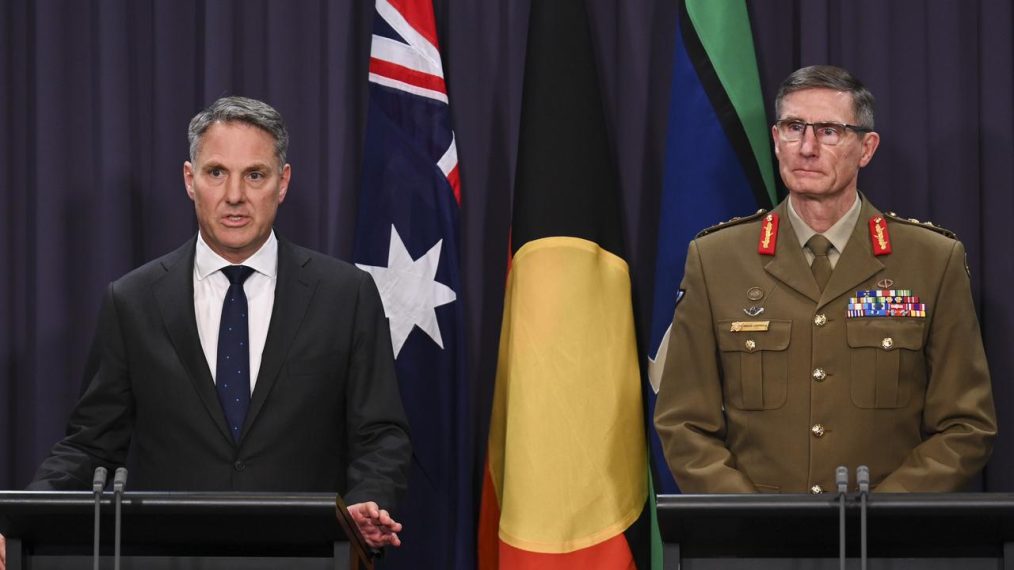Diggers’ fury as commanders duck responsibility for war crimes, report warns
Defence Minister Richard Marles and Defence Force chief General Angus Campbell. Picture: NCA NewsWire/Martin Ollman
FOREIGN AFFAIRS AND DEFENCE CORRESPONDENT
The refusal of the nation’s military leaders to accept responsibility for war crimes in Afghanistan has generated “anger and bitter resentment” among serving personnel and veterans that will take years to overcome, an independent report has warned.
The Afghanistan Inquiry Implementation Oversight Panel’s final report is due to be tabled in the Senate after Defence Minister Richard Marles quietly authorised its release six months after he received the document.
The report, obtained by The Australian, says the panel does not accept the Brereton inquiry’s finding that senior commanders should not be held accountable for the murders of 39 Afghans by up to 25 special forces soldiers.
It says there has been “an unmet need for Defence senior leadership to communicate to the serving and ex-serving ranks of the ADF that they collectively accept organisational responsibility and accountability for part of what went wrong in Afghanistan”.
“There is ongoing anger and bitter resentment amongst present and former members of the special forces, many of whom served with distinction in Afghanistan, that their senior officers have not publicly accepted some responsibility for policies or decisions that contributed to the misconduct, such as the overuse of special forces,” the panel warns.
Special Operations Task Group soldiers undergo training during the Afghanistan war. Picture: Corporal Chris Moore.
The report says the resentment among special forces soldiers was “expressed forcefully and repeatedly to the panel by Defence members of all ranks” during visits to SAS and 2nd Commando Regiment headquarters.
The anger in the Defence and veterans’ community over the issue will “likely to last for a long time”, the panel warns.
The panel led by former Inspector-General of Intelligence and Security Dr Vivienne Thom says commanders need to accept accountability to “prevent or mitigate any recurrence” of such crimes.
The report compares the failure of Defence’s senior leaders to accept accountability for war crimes with the actions of company CEOs who face dismissal and even criminal charges after major corporate collapses.
“In the private sector, major corporate failures result in both an organisational and individual responsibility,” the report says.
“Personal knowledge or direct involvement of the senior officers in the causes or behaviour that led to the corporate failure are not required.”
The report comes as Mr Marles sits on recommendations by outgoing Chief of the Defence Force Angus Campbell on the stripping of honours and awards for commanders for war crimes that occurred on their watch.
Australian Special Operations Task Group soldiers prepare to board a helicopter during the Afghanistan war. Picture: Defence
It says “substantial progress” has been made in addressing special forces cultural issues highlighted by Justice Paul Brereton in his report for the Inspector General of the Australian Defence Force.
“While there are still occasions when individuals exhibit behaviours indicative of unhealthy exceptionalism, today the responses from the leadership appear to be rapid, clear and appropriate,” the report says.
But it warns there are still some signs of the “toxic competitiveness” between the SAS and 2nd Commando Regiments that Justice Brereton identified as a contributing factor, with “significant and forceful comments” by some soldiers on their rival regiments in interviews by the panel.
The Albanese government is yet to implement a Brereton inquiry recommendation to compensate the families of Afghans unlawfully killed by Australian Defence Force troops.
But the panel says it accepts the government faces difficulties in identifying, locating and paying those affected since the fall of Kabul to the Taliban.
FOREIGN AFFAIRS AND DEFENCE CORRESPONDENT
Ben Packham is The Australian’s foreign affairs and defence correspondent. To contact him securely use the Signal App. See his Twitter bio for details…. Read









